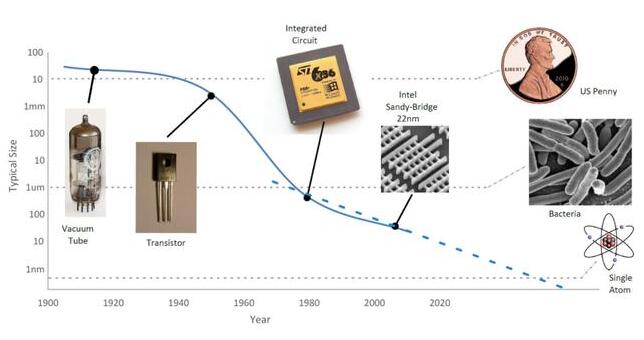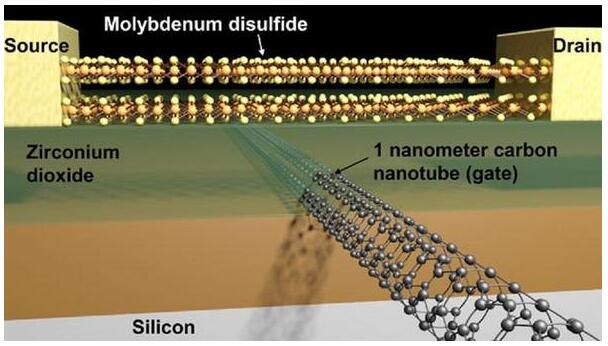In the 1950s, Gordon Moore, co-founder of Fairchild Semiconductor and Intel, published a paper pointing out that the number of components per integrated circuit will double every year in the next decade. In 1975, he reviewed his forecast and said that the number of components now doubled every two years. This is the famous Moore's law.

Moore's law has been proved to be correct for decades. Moreover, Moore's law has been guiding chip manufacturing and design. Researchers at Intel and AMD have always set goals and targets according to Moore's law. As Moore's law forces the rapid development of chip design, computers become smaller and smaller. Moore's law is not just a prediction, it has become the goal and standard that manufacturers aim to achieve. Here are some examples of Moore's Law:
In 1971, one of the first semiconductor processes was 10 microns (or 100000 times smaller than a meter). By 2001, it was 130 nm, nearly 80 times smaller than that in 1971.
As of 2017, the transistor process was 10 nm. Compared with human hair, the diameter was 100 microns, nearly 10000 times larger than today's transistors.
Moore's law crisis
With the development of large-scale circuits, transistors are getting smaller and smaller, and the number of integrated circuits is increasing in geometric order, but its manufacturing process is becoming more and more difficult. Overcoming these technical and technological barriers requires not only a lot of time and research, but also a lot of capital and investment. Therefore, the time in Moore's law also gradually slows down, and even it may not be established soon, and the crisis of Moore's law breaks out (of course, it is inevitable if there is no great change).
It took Intel about two and a half years to develop from the 22nm process in 2012 to the 14nm process in 2014. After that, the research and development of 10nm has been problematic and delayed for many times. It may not be available until 2019. However, the good news is that AMD 7Nm graphics card and CPU will be available in 2019 (see the recent article "amd future product outlook...". Because Moore's law is not a real law, but a prediction or speculation. Although chip manufacturers have been committed to achieving and maintaining their goals, it has become increasingly difficult.
Quoting Moore himself in 2015: "I think Moore's law will die out in the next decade or so".
quantum tunneling
As electronic components become smaller and smaller (nano scale), quantum properties and effects gradually appear. As we continue to reduce the size of the transistor, the size of the PN junction depletion layer is also decreasing. The depletion layer is very important to prevent the flow of electrons. The researchers calculated that transistors less than 5nm will not be able to stop the flow of electrons due to the tunneling effect of electrons in their depletion region. Due to tunneling, electrons will not perceive the depletion region and "cross" directly. If you can't stop the flow of electrons, the transistor will fail.
In addition, we are now slowly approaching the size of the atom itself. Theoretically, we can't build a transistor smaller than the atom. The diameter of silicon atoms is about 1 nm, and the gate size of our transistors is about 10 times that size. Even without considering quantum effects??, We will also reach the physical limit of transistors and cannot be smaller.

Current and heating effects
In addition to quantum tunneling and physical limits, there are two very restrictive process problems, that is, the heating effect of small-size transistors. As transistors become smaller, transistors tend to become more "leaky", even in the off state. It is also inevitable to let some current pass through. This is called leakage current. If we set the leakage current to 100 Na, if the CPU has 100 million transistors, the leakage current will be 10A. This will drain the phone battery in a few minutes. Higher gate voltage can reduce leakage flow, but this will lead to more heating effect. Even without considering it, each clock calculation itself consumes a lot of heat. Manufacturers must use these attributes and make them just right to prevent these effects. As the process becomes smaller and smaller, the process becomes more and more difficult.
High leakage current can also lead to problems of dark silicon and dark memory. Even though there may be many transistors in our chip, most transistors must remain off to prevent the chip from overheating and melting. All these off state transistors take up a lot of space that can be used to place other components. This leads to the question: do we really need to be smaller, or do we improve the existing chip design?
Future outlook
5nm design
Considering all these factors, Intel executives and the international semiconductor technology roadmap indicate that 5 nm may be the limit size that can be reached. It is expected that 5 nm will make its debut in 2021. So what else can we expect after that?
Dennard's scaling dennard scaling is considered to be the sister method of Moore's law. It was developed by Robert dennard in 1974 and pointed out that as transistors become smaller, their power density will decrease. This means that as transistors become smaller, the amount of voltage and current required to operate them will also decrease. This law allows manufacturers to reduce the size of transistors and increase the clock speed by a large jump per iteration. However, around 2007, dennard's scaling collapsed. This is because at a smaller size, the leakage current will cause the transistor to heat up and produce further loss.
We may have noticed that although the transistors have become smaller, the CPU computing rate has not increased in the past decade due to the dennard scaling crash. The high loss at high clock rate is also the reason why smart phone chips use lower clock speed (usually 1.5 GHz).
Kume's law
By improving the current chip implementation and better instruction pipeline, we can improve the performance of the chip. So Stanford professor Jonathan kumey proposed koomey's Law: the number of calculations per joule of energy will double every 1.5 years. This situation is expected to continue until 2048, when Landauer's principle and simple laws of thermodynamics will prevent further improvement. At present, the computer efficiency of Landauer limits is about 0.00001%.
Multi core architecture
Traditional programming languages (such as Java, C + + and python) can only run on a single device. But as devices become smaller and cheaper, we can run the same programs simultaneously or in parallel on many chips to further improve performance. In this regard, languages such as golang and node will play a more important role.
New material research
Researchers around the world are looking for newer and more innovative ways to make smaller and faster transistors. It has been proved that materials such as gallium nitride and graphene have less loss at faster switching frequency.
Quantum computing
At present, the possible solution is to develop quantum computers. Companies like d-wave and rigetti computing are working extensively in this field. More importantly, the expansion of qubits' law has not yet begun. The way to bypass dennard scaling is to put more cores in a single chip to improve performance. At present, quantum computing has shown great prospects. Its advantage is that it can have multiple states (different from other computers 0 and 1). At present, some experimental quantum computing has achieved good results, such as the real random number algorithm based on quantum technology has been successful.